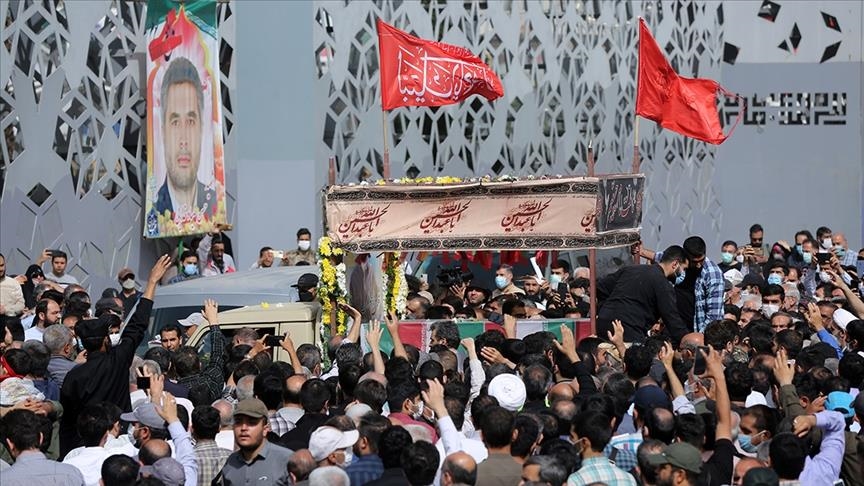High-profile assassinations of Iranian figures blamed on Israel
Iran blames Israel for assassinating high-profile military, nuclear figures

TEHRAN
An officer in Iran’s Islamic Revolutionary Guard Corps (IRGC) was shot dead Friday by unknown assailants on a motorcycle outside his home in east Tehran.
Many see a striking similarity between Col. Sayyad Khodayari’s assassination and that of legendary Iranian military commander Sayyad Shirazi, who was killed outside his home 23 years ago.
Between Shirazi and Khodayari, there have been many high-profile assassinations of Iranian military figures as well as nuclear scientists over the years, with fingers pointing outside the border.
While it was Mojahideen e Khalq (MeK), an armed opposition group operating overseas, which was blamed for the assassinations of top Iranian political and military figures after the 1979 revolution, since 2010 it has mostly been the Israeli spy agency and local handlers.
On Mossad’s radar have essentially been Iran’s nuclear scientists, many of whom have been killed in targeted attacks since 2010, some in the nation’s capital of Tehran.
The high-profile assassination of top nuclear scientist Mohsen Fakrizadeh on Nov. 27, 2020 grabbed headlines worldwide and prompted Tehran to ramp up its nuclear activities in retaliation.
Fakhrizadeh, who headed the research and innovation division at Iran’s Defense Ministry, was a high-value target for Mossad who had survived many attempts on his life.
It eventually took a remote-controlled device and a sophisticated military operation to kill him on the outskirts of Tehran. Iran blamed Israel even though Tel Aviv neither confirmed nor denied the murder.
Fakhrizadeh had largely been a mysterious figure, who was believed to have headed what the UN nuclear watchdog and US spy agencies said was a nuclear program that was halted in 2003.

In April 2018, then-Israeli premier Benjamin Netanyahu mentioned Fakhrizadeh as a leading figure in what he described as Iran’s clandestine nuclear weapons work.
Fakhrizadeh was perhaps the most high-profile target but he was not the first one.
Masoud Alimohammadi was killed on Jan. 12, 2010 outside his home in a northern suburb of Tehran, the first of many assassinations that Iran blamed on Israel.
A renowned quantum field theorist and elementary-particle physicist, Alimohammadi taught at Tehran University’s Department of Physics. He was leaving for class when he was blown up by a remote-controlled bomb attached to a motorcycle parked on the street.
No one claimed responsibility for the attack but a Foreign Ministry spokesman was cited as saying that it was the handiwork of a “triangle of wickedness,” referring to Israel, the US and their local agents.
There were also reports that Alimohammadi was not directly associated with Iran’s nuclear enrichment program and he was largely apolitical, but all factions claimed him as their own after his killing.
A group of suspects arrested for his murder included Majid Jamali Fashi, who confessed on live television and claimed he had received arms training in Israel.
One month before Alimohammadi was killed, nuclear scientist Ardeshir Hassanpour died under mysterious circumstances in what officials characterized as a gas poisoning incident, attributed to Mossad.
Next on the radar was Majid Shahriari, who was killed on his way to work at Shahid Beheshti University in north Tehran on Nov. 29, 2010. His wife was injured in the incident.
In a similar pattern, assassins riding motorcycles attached a bomb to his car.
Shahriari was a nuclear science and technology professor at Shahid Beheshti University and was closely associated with Iran’s nuclear program, with expertise in nuclear reactors, fuel cycles, radiotherapy engineering, etc.
On the same day, in another part of the capital, another prominent nuclear scientist, Fereydoun Abbasi-Davani, and his wife, survived an assassination attempt.
Fereydoon, an expert in neutron physics, later went on to become the head of the country’s atomic energy agency from 2011 and 2013, during the presidency of Mahmoud Ahmedinejad.
The dance of death continued as Darioush Rezaeinejad, a 35-year-old electrical engineer working at a national security research facility, was shot at by unknown gunmen when he was driving home with his wife after picking up their daughter from a kindergarten in Tehran on July 23, 2011.
While some reports said he was associated with the Defense Ministry, it was never made clear what role he played in advancing Iran’s nuclear enrichment program.
On Nov. 14, 2011, a towering military figure, known as Iran’s “missile man,” Maj. Gen. Hassan Tehrani Moghaddam, was killed in a powerful explosion near Tehran, along with 17 IRGC personnel.
While some reports said it was an accident, officials maintained that the attack was carried out by Israel’s intelligence agency.
At his funeral, Maj Gen. Hossein Salami, who now heads the IRGC, hailed Moghaddam as “the main architect of the IRGC’s cannon and missile power.”
Mustafa Ahmedi-Roshan, a nuclear scientist who supervised a department at the strategic nuclear site in central Isfahan’s Natanz, was the next to fall to a magnetic bomb attached to his car in northern Tehran on Jan. 11, 2012.
He was the youngest and also the most promising, according to experts. His killing interestingly resembled the killing of all other nuclear scientists before him.
His killing was also attributed to Israel, with a senior government official saying Mossad agents “cannot prevent progress” in Iran’s nuclear program.
While Iran maintains its nuclear program is peaceful, Western countries have for years accused it of harboring ambitions to build a bomb.
Israel, which sees Iran as an “existential threat,” has openly spoken against Iran’s nuclear program but it has never accepted responsibility for attacks on Iranian scientists or nuclear facilities.
Anadolu Agency website contains only a portion of the news stories offered to subscribers in the AA News Broadcasting System (HAS), and in summarized form. Please contact us for subscription options.







